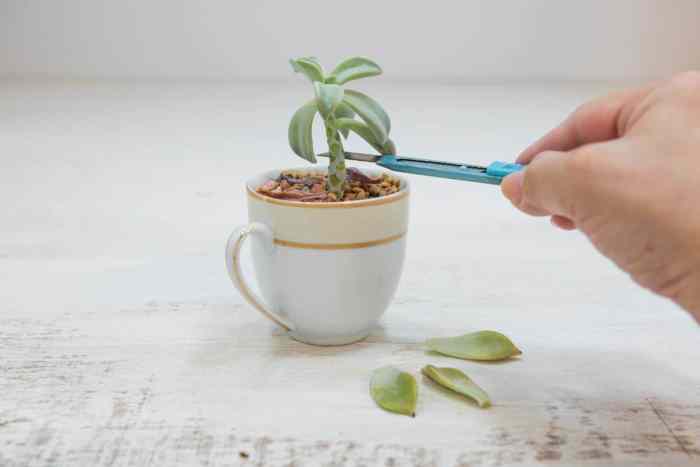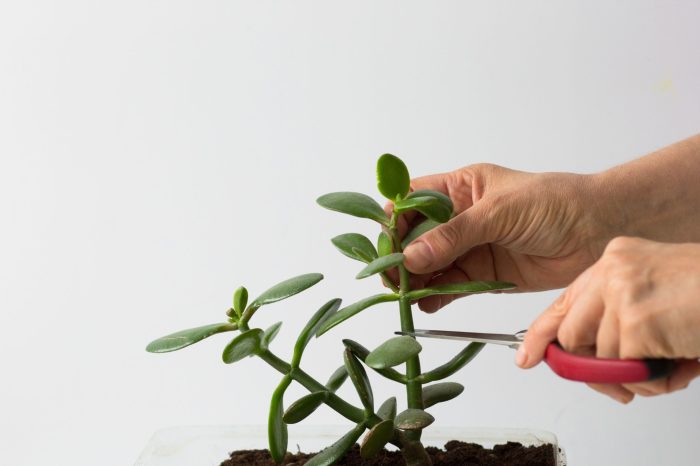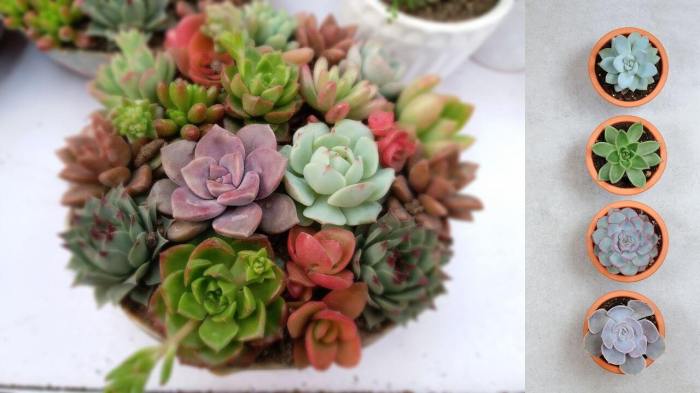When it comes to succulent care, trimming is an essential task that can greatly enhance the health and appearance of your plants. Whether you’re a seasoned succulent enthusiast or a beginner just starting out, understanding how to trim succulent plants is crucial for maintaining their optimal growth and beauty.
This comprehensive guide will delve into the intricacies of succulent trimming, providing step-by-step instructions, essential tools, and expert tips to help you achieve the desired results for your succulent collection.
Overview of Succulent Trimming

Succulent trimming is a crucial aspect of succulent plant care, ensuring their health, aesthetic appeal, and longevity. Regular trimming promotes healthy growth, prevents overcrowding, enhances light penetration, and improves air circulation.
Importance of Trimming Succulent Plants
Succulents store water in their thick, fleshy leaves, stems, or roots. Over time, they can become leggy or overcrowded, leading to reduced light exposure and airflow. Trimming removes dead, damaged, or overgrown parts, allowing healthy growth to flourish.
Benefits of Regular Trimming
Regular trimming offers numerous benefits for succulent plants:
- Encourages new growth and prevents legginess
- Improves light penetration, promoting photosynthesis
- Enhances air circulation, reducing the risk of pests and diseases
- Creates a more compact and aesthetically pleasing appearance
- Propagates new plants from cuttings
Step-by-Step Guide to Basic Succulent Trimming Techniques
1. Gather necessary tools
sharp scissors, tweezers, and rubbing alcoholDisinfect tools to prevent the spread of bacteria
Succulent plants require specific trimming techniques to maintain their health and aesthetics. Similarly, palm plants also benefit from proper trimming to enhance their appearance and growth. For detailed instructions on how to trim palm plants, refer to our comprehensive guide how to trim palm plant . Returning to succulent plants, trimming should focus on removing dead or damaged leaves, promoting airflow, and shaping the plant for a more compact and visually appealing form.
-
3. Identify areas for trimming
remove dead or damaged leaves, overgrown stems, and excess offsets
- Cut cleanly with sharp scissors, avoiding tearing
- Remove offsets by gently twisting them off or using tweezers
- Treat larger cuts with rubbing alcohol to prevent infection
Tools and Materials

Trimming succulents requires specific tools and materials to ensure precise cuts and minimize damage to the plant. Choosing the right tools for the job is crucial, as different succulent varieties have varying characteristics and require specialized care.
Essential tools for succulent trimming include:
- Sharp knife:A sharp, sterile knife is ideal for making clean, precise cuts on succulent stems and leaves.
- Shears:Shears are useful for trimming larger stems or removing dead leaves. Choose shears with sharp, pointed blades for clean cuts.
- Gloves:Gloves protect hands from the sap or spines of some succulent varieties.
In addition to these basic tools, specialized tools may be required for specific succulent varieties:
- Scalpel:A scalpel is a small, sharp knife used for delicate cuts on smaller succulents or for removing offsets.
- Tweezers:Tweezers are helpful for removing small leaves or debris from succulents.
- Pruning saw:A pruning saw is used for cutting thick or woody succulent stems.
When selecting tools for succulent trimming, consider the size, shape, and texture of the succulent. Smaller succulents may require smaller tools, while larger succulents may need more robust tools. The sharpness of the tools is also important to ensure clean cuts that minimize damage to the plant.
Specific Trimming Techniques

Trimming succulent plants is not just about removing excess growth; it’s an art that requires precision and an understanding of the plant’s unique characteristics. Different succulent shapes and sizes demand specific trimming techniques to maintain their health and aesthetics.
Trimming succulent plants involves removing dead or damaged leaves and stems to maintain their health and appearance. For instance, if you have a jade plant, you can follow specific trimming techniques to encourage healthy growth and prevent overcrowding. To learn more about trimming jade plants, refer to our comprehensive guide how to trim jade plants . Trimming succulent plants regularly promotes their overall well-being and enhances their aesthetic appeal.
Trimming techniques vary depending on the type of succulent, whether it’s a rosette-forming succulent, a trailing succulent, or a columnar succulent. Each type requires a different approach to ensure optimal growth and appearance.
Trimming Rosette Succulents
- Rosette succulents, such as Echeveria and Sempervivum, form compact clusters of leaves that grow in a spiral pattern.
- To trim rosette succulents, gently remove any dead or damaged leaves from the outer edges of the rosette.
- Avoid cutting into the center of the rosette, as this can damage the plant’s growth point.
Trimming Trailing Succulents
- Trailing succulents, such as Sedum and Senecio, have long, cascading stems that can grow several feet in length.
- To trim trailing succulents, cut back any excessively long or unruly stems to encourage bushier growth.
- You can also trim off any dead or damaged leaves or stems to maintain the plant’s health and appearance.
Trimming Columnar Succulents
- Columnar succulents, such as Cacti and Euphorbia, have a tall, upright growth habit.
- To trim columnar succulents, remove any dead or damaged growth from the base of the plant.
- You can also cut off any offsets or pups that form at the base of the plant to propagate new plants.
Aftercare and Maintenance
Trimming succulents requires proper care to ensure their continued health and well-being. Following the procedure correctly will help prevent infection, promote new growth, and maintain the plant’s aesthetic appeal.
Trimming succulent plants requires precision and care to maintain their health and shape. Similarly, when trimming bushes, proper techniques are crucial to ensure a neat and controlled appearance. For detailed instructions on trimming bushes, refer to how to trim the bushes . Returning to succulent plant trimming, it’s important to use sharp shears and make clean cuts to avoid damaging the plant.
After trimming, it’s essential to provide the succulent with the right environment and care to promote healing and encourage new growth. This includes proper watering, fertilizing, and providing adequate lighting.
Watering, How to trim succulent plants
Water the succulent sparingly after trimming, as overwatering can lead to root rot. Allow the soil to dry out completely before watering again. The frequency of watering will vary depending on the succulent’s species, size, and growing conditions.
Fertilizing
Fertilize the succulent monthly during the growing season (spring and summer) with a balanced, diluted liquid fertilizer. Avoid over-fertilizing, as this can burn the plant’s roots.
Lighting
Provide the succulent with bright, indirect light. Avoid placing the plant in direct sunlight, as this can scorch the leaves. If the succulent is not getting enough light, it will become leggy and weak.
Common Problems and Solutions
Some common problems that can occur after trimming succulents include:
- Infection:If the succulent is not properly sterilized before trimming, it can become infected. To prevent infection, sterilize your tools with rubbing alcohol before using them.
- Root rot:Overwatering can lead to root rot, which can be fatal to the succulent. To prevent root rot, allow the soil to dry out completely before watering again.
- Leggy growth:If the succulent is not getting enough light, it will become leggy and weak. To prevent leggy growth, provide the succulent with bright, indirect light.
Advanced Trimming Techniques: How To Trim Succulent Plants

Beyond basic trimming, advanced techniques allow for shaping and styling succulents into unique artistic forms.
Topiaries and Bonsai
Topiaries involve trimming succulents into specific shapes, such as animals, geometric figures, or letters. Bonsai is a Japanese art form where succulents are miniaturized and trained into intricate shapes using wires and pruning.
Wires and Supports
Wires or other supports can be used to guide and shape succulent growth. Bendable wires allow for gradual adjustments, while rigid supports provide more stability. Proper technique is crucial to avoid damaging the plant.
Artistic Forms
Advanced trimming techniques enable the creation of various artistic forms, such as living sculptures, miniature gardens, and wall-mounted displays. These arrangements showcase the diversity and beauty of succulents while adding a touch of greenery to any space.
Last Point
By following the techniques and advice Artikeld in this guide, you’ll be well-equipped to trim your succulent plants with confidence and precision. Remember, trimming is an ongoing process that requires patience and observation. With regular care and attention, your succulents will thrive and become a stunning addition to your home or garden.
Expert Answers
What are the benefits of trimming succulent plants?
Trimming succulent plants offers numerous benefits, including improved air circulation, reduced risk of disease, enhanced light exposure, and promotion of new growth.
How often should I trim my succulent plants?
The frequency of trimming depends on the growth rate and species of your succulents. As a general rule, trim when the plant becomes leggy, overgrown, or has dead or damaged leaves.
What tools do I need for succulent trimming?
Essential tools for succulent trimming include sharp shears or a knife, gloves, and a clean work surface. For specialized trimming techniques, you may also need wires or other supports.